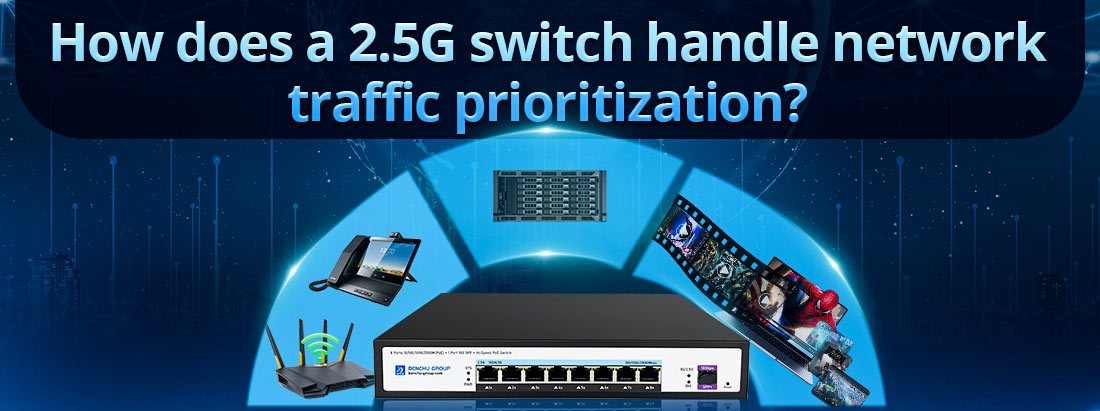
A 2.5G switch handles network traffic prioritization primarily through the use of Quality of Service (QoS) features, which allow the switch to differentiate between different types of traffic and prioritize time-sensitive or critical data streams over less important traffic. This ensures that essential applications like voice, video, or gaming are given preferential treatment, minimizing delays, jitter, and packet loss. Below is a detailed description of how this process works:
1. Traffic Classification
Traffic classification is the first step in prioritization, where the switch identifies and categorizes incoming packets. This can be done using several parameters, including:
--- Port-Based Classification: The switch assigns priority based on the port to which a device is connected. For example, a port connected to a VoIP phone or a video conferencing system might receive higher priority.
--- VLAN-Based Classification: If the network uses VLANs (Virtual Local Area Networks), traffic from specific VLANs can be given higher or lower priority.
--- Protocol-Based Classification: The switch can identify traffic by its protocol, such as HTTP, FTP, VoIP, or video streaming, and assign priority levels based on the protocol type.
--- IP Address or Subnet: Traffic from specific IP addresses or subnets can be prioritized, allowing the network administrator to give preference to critical servers, devices, or users.
2. Marking and Tagging Traffic
After classification, traffic is tagged with a priority level. This is typically done using the following methods:
--- 802.1p Priority Tagging: In the case of Ethernet frames, the switch can use the 802.1p field in the VLAN header to assign a priority level (ranging from 0 to 7). Higher numbers represent higher priority.
--- DSCP (Differentiated Services Code Point): For IP traffic, DSCP markings in the packet header indicate the priority. Higher DSCP values indicate higher priority for the switch and routers to follow. This marking ensures that devices along the network path recognize which traffic should be treated as more important.
3. Queue Management
Most modern switches, including 2.5G switches, implement multiple queues to manage network traffic. Each queue can have a different priority level:
--- High-Priority Queues: Time-sensitive traffic such as VoIP, video conferencing, or real-time gaming packets are placed into high-priority queues.
--- Low-Priority Queues: Non-critical traffic such as file transfers, background updates, or email traffic is placed into lower-priority queues.
The switch manages how packets in each queue are forwarded based on the priority assigned. The two common algorithms used are:
--- Strict Priority Queuing (SPQ): In this method, packets from higher-priority queues are always forwarded first, ensuring that critical traffic gets immediate attention. However, this can cause lower-priority traffic to be delayed if high-priority traffic is continuous.
--- Weighted Fair Queuing (WFQ): In this method, all queues are serviced, but higher-priority queues receive more bandwidth. This ensures that lower-priority traffic is still transmitted, albeit at a slower rate when the network is congested.
4. Traffic Shaping and Policing
Traffic shaping and policing are methods used to manage bandwidth allocation and prevent network congestion:
--- Traffic Shaping: The switch can limit the rate at which certain types of traffic are sent, smoothing out bursts of data and ensuring that critical traffic has enough bandwidth. For instance, bulk file transfers might be limited to prevent them from consuming too much bandwidth.
--- Policing: The switch can enforce traffic limits, dropping or marking packets that exceed predefined bandwidth thresholds. This is useful for preventing certain types of traffic from overwhelming the network.
5. Congestion Management
When the switch detects network congestion, it can make real-time decisions to drop or delay low-priority packets to maintain performance for high-priority traffic. This is done using various methods:
--- Random Early Detection (RED): This technique involves dropping packets randomly from low-priority queues when the switch detects that congestion is imminent, freeing up bandwidth for higher-priority traffic.
--- Tail Drop: If a queue is full, packets at the end of the queue are dropped. Higher-priority queues are less likely to experience tail drops because they are processed faster.
6. Bandwidth Reservation
--- 2.5G switches can also support bandwidth reservation for critical applications, ensuring that a certain amount of bandwidth is always available for high-priority traffic. This can be achieved using protocols like RSVP (Resource Reservation Protocol) or by manually configuring policies that allocate bandwidth to specific types of traffic or applications.
7. Link Aggregation
--- In cases where a network requires more bandwidth than a single port can provide, link aggregation can be employed. This involves combining multiple physical connections into one logical connection, increasing the available bandwidth and ensuring smoother traffic flow. Although this does not directly prioritize traffic, it helps alleviate congestion by providing more capacity for all types of traffic, including high-priority streams.
Conclusion:
A 2.5G switch handles network traffic prioritization by using QoS features to classify, tag, queue, and shape traffic, ensuring that critical applications such as voice, video, and real-time gaming receive the necessary bandwidth and low latency. By intelligently managing traffic based on defined priorities, the switch can ensure smooth network performance, even under heavy loads, which is essential in environments with multiple types of data transmission happening simultaneously.